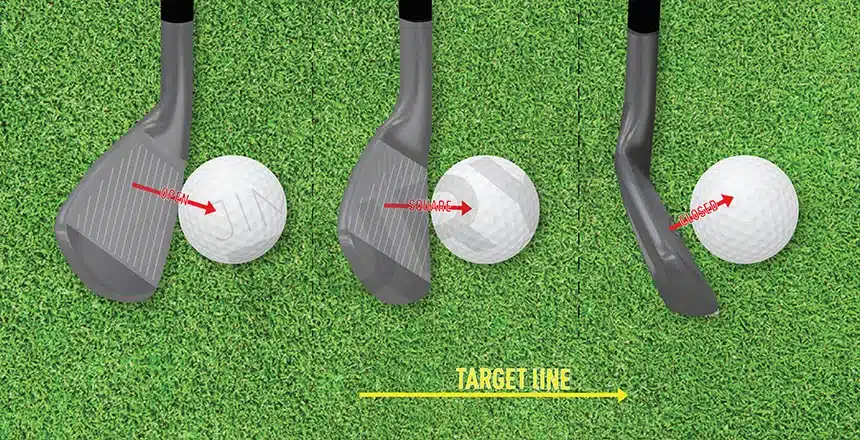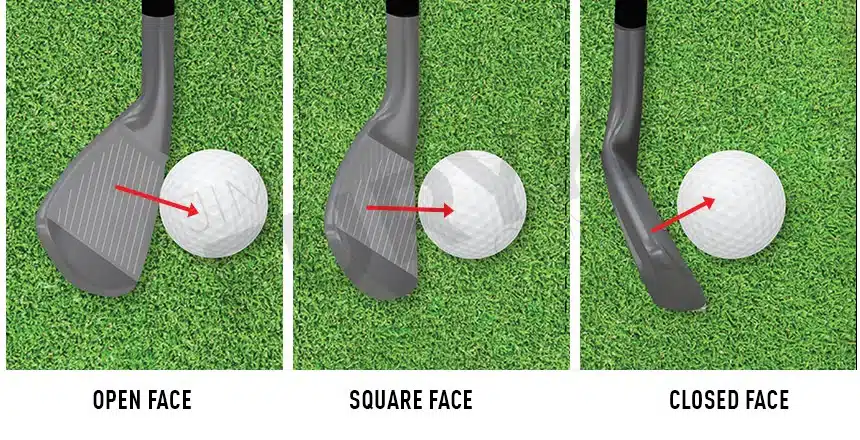An open clubface at address is something that is done both intentionally and unintentionally. In the case of the latter, that’s how you end up hitting slices, while the former results in controlled, well-intended fade shots that turn away, in flight, from hazards. So knowing how to open clubface in golf purposely will help in gaining better scores.
A round of golf can be both predictable and unpredictable, no matter your golfing skills. Hence, it’s not so surprising when, during your game, you feel the need to keep the clubface open at impact. But this is easier said than done because opening the clubface has a lot to do with forming that “perfect” grip.
In This Post
Open Clubface At Address – What Does An ‘Open Clubface’ Mean?
It’s the moment when the clubface or club face aligns toward the right side of your target. So the clubface is facing right when it should be pointing straight down your target line, and not to the right. An open clubface points toward the right in the case of right-handed golfers and left for lefties.
The clubface position at address and impact, when open, as opposed to closed or square, is not the most ideal. Unless it’s done intentionally to hit a fade shot i.e. to produce a left-to-right ball flight deliberately for saving strokes in your every round of golf. However, if the fade is uncontrolled or unintended, then the open clubface will lead to a mis-hit where the golf ball curves toward the right during flight.
Please note that for left-handed players, the open clubface points toward the left, thus mis-hits have the ball flying to the left.
If you find yourself slicing your shots way too much, which is mostly what beginners and recreational golfers do, it’s probably because of that open clubface at the moment of impact.
When Should You Open the Clubface?
Like I said earlier, many golfers purposely open the clubface at impact in order to achieve a goal, and that is to generate a certain kind of ball flight. This ball flight is known as a fade. How much the clubface opens decides how much toward the right the golf ball will curve (or toward the left if you’re left-handed) in flight.
Fade shots require a normal stance as well as regular, proper alignment. The only difference is that you open that clubface at the time of your address position. This involves turning, not your hands, but the golf club in those hands. You intentionally open the clubface at address and then carry on with the grip.
On the other hand, when the clubface stays open accidentally, the possibility of slicing your shot gains momentum. The open clubface, after all, is just the explanation for why you’re slicing the ball (where it curves toward the right). It also results in a ‘push’ ball flight – shots that fly toward the right side of your target, but this flight is straight instead of being curved.
Therefore, too many pushes or slices (i.e. uncontrolled or weak fades) call for checking clubface orientation at address. It’s only when the left-to-right ball flight is both desired and controlled that an open clubface is supposed to be a “good” thing. Otherwise, you’re just going to end up with slices all the time!
Finally, it all makes sense now why top-rated golf drivers for beginners and high handicappers have a calculatedly closed clubface design. Most high-handicap and newcomer golfers slice quite a lot, which demands an in-built closed clubface to cure their slices.
How to Open the Clubface Intentionally?
If you want to properly set up to keep the clubface open at address, just simply hold the golf club in a way (by turning the club and not your hands) that the face remains in an open position. You know you’re doing it wrong if the strength of your grip is not the same as it is when you normally hold the golf club to square the clubface at address.
An open clubface at address with strong grip, instead of your normal, neutral grip, is not the ideal setting. Likewise, even if you grip your club normally but then rotate your hands for adjusting the clubface at address, that face modification is still going to come about as a result of your grip strength, which automatically gets the clubface to square up on impact.
So you may think you’re opening the clubface at the point of address, but that’s not what’s actually happening. Because the face will return to square during the time it takes to hit the golf ball.
Golf Clubface Open At Address – 3 Major Effects Produced!

The open clubface – where the face of the golf club is pointing toward the right side of your target – directs the shot to the right of that target. This has already been stated many times before.
Perhaps, what has not been mentioned so far is that an open clubface position increases the loft angle of the golf club, thus generating a higher ball flight as well.
Lastly, when the clubface is open at address, this orientation also shoots up the bounce factor. That means your golf club will shoot up from the turf, sand, etc. instead of digging through the ground.
Does the Open Clubface Cause Slices?
Slicing your shots has a lot to do with how much sidespin is created. In that case, an open clubface generates sidespin, which leads to a slice.
So instead of getting the clubface to cut across the golf ball on impact, by gripping your golf club in a way that it comes over the top of your initial downswing, focus more on allowing that clubface to take on a more neutral or normal swing path.
This way, you can actually hit straight shots. Here’s more on how to effectively go about fixing your slices.
What Are the Causes of the Open Clubface?
In most cases, the incorrect grip is the culprit behind opening the clubface.
The solution – adjust your grip simply by rotating both hands toward the right if you’re a right-handed golfer or toward the left if you’re a leftie.
What In Your Golf Swing Causes the Clubface to Open?
It’s your body movements and bio-mechanics, to be more specific/technical. When you swing your golf club using the arms rather than using your entire body, premature arm movement comes into play, even in the downswing (although this is less common).
Whatever the case, early arm or hand action/movement is bound to create a flat effect through impact. As a result, this will either close or open the clubface position at impact.
Conclusion
You may have spent a whole lot of time, effort, and also money on perfecting your golf swing. But have you ever considered if all of the elements in your swing are right? Because even if a tiny fraction is wrong, putting up a good game becomes very, very challenging. And what plays a major role in all of this is the clubface orientation or position at impact.
It matters how you position your stance in relation to the golf ball since even this particular factor determines flight path. Nevertheless, nothing matters as heavily as the actual clubface orientation when it comes to affecting ball direction, at least initially.
So, in this article, the meaning, causes, effects, etc. of an open clubface have been discussed, along with how to intentionally open the clubface for producing a certain type of ball flight that your round of golf and scores can benefit from.

